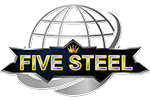As it is well acknowledged, since the invention of steel, metalworkers have produced different grades of steel based on the applications. This is done by varying the amount of carbon. Today, carbon steel pipe is one popular member of steel pipes in various applications. Generally, steel recipes have a weight proportion of carbon in the 0.2% to 2.1% range. To enhance other properties of the base iron, mixtures may also include chromium, manganese, or Tungsten. But the proportion of these materials is not specified.
Carbon steel pipe is frequently used in various applications because it is durable and safe. Building materials underground may be susceptible to rotting and pests. Steel will not rot and is impervious to pests like termites. Steel also doesn’t need to be treated with preservatives, pesticides or glue, so it is safe to handle and work around. Since steel is non-combustible and makes it harder for fire to spread, it is good to use carbon steel pipe for structural steel pipe when building homes. Steel frame buildings are more resistant to natural disasters like tornados, hurricanes, lightning strikes, and earthquakes. Furthermore, carbon steel pipe is highly resistant to shock and vibration. Fluctuating water pressure or shock pressure from a water hammer have little effect on steel. Today’s heavy traffic conditions impose much stress on roadway foundations. Carbon steel pipe is practically unbreakable in transport and service, and for this reason it is okay to lay water mains under roadways.
For any given pressure, carbon steel pipes can be made much thinner than pipes made from other materials, so they have a greater carrying capacity than pipes of other materials with the same diameter. And the unmatched strength of steel piping increases longevity and reduces the need for replacement as well as repairs. Steel pipe manufacturers can produce pipes in many dimensions, from less than an inch to over five feet. They can be bent and wrought to curve and fit anywhere they need to be. Joints, valves and other fittings are widely available at good prices.
Mild steel pipe is available in a variety of structural shapes that are easily welded into pipe or tube and etc. Most of them are easy to fabricate, readily available, and cost less than most other metals. In well protected environments, the life expectancy of mild steel pipe is 50 to 100 years. Unlike high-carbon steel pipe, mild steel pipe has carbon contents of less than 0.18%, so this type of pipe is easily welded while some types of high-carbon steel pipe, such as stainless steel pipe, which requires special techniques in order to properly weld the material. Today, mild steel pipe has been used for most of the pipelines in the world, for it is not only be easily welded into place flexibly but also can somewhat avoid cracking and breaking under pressure.
Send your message to us:
Post time: Apr-15-2019





